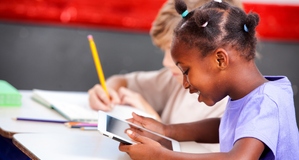Featured Article:The Implementation of Social Software in Authentic Literacy ActivitiesDefinitionsAuthentic Literacy ActivitiesStudents engage in deep reading based on provocative questions posed before reading, and then have the opportunity to argue and support an interpretation from one or more texts. This approach can be provided across the disciplines. These activities involve writing to learn, writing to disclose learning, writing to express opinions and writing to connect (VanDeWeghe, 2008). Authentic TextA text (written or read) must be like texts that are used by readers and writers outside of a learning-to-read-or-write context (i.e., to serve communicative purposes or functions). For example, a newspaper read in class must be either a newspaper brought in from outside the classroom or a newspaper specially written for the classroom that is close to identical in form, language, and so on to one from outside the classroom (Duke et al. 2006). Multimodal LiteracyRefers to meaning-making that occurs through the reading, viewing, understanding, responding to and producing and interacting with multimedia and digital texts (Walsh, 2010).Social SoftwareIs a class of networked tools that support and encourage individuals to learn together while retaining individual control over their time, space, presence, activity, identity and relationship. They include blogs, wikis, social networking sites (SNS) and social bookmarking (Minocha, 2009 & Anderson, 2005). Authentic Literacy and TechnologyEducators have been engaged with authentic learning and authentic literacy activities without the use of technology for years. Authentic literacy practices allow students “to use meaningful functional oral and written language” in an environment where others are supporting and engaging them in this activity (Branitz, 1994, p. 588). One way that students engage in such practice is through “dialogue journals” that are “written conversations between teachers and students or students and students” (Branitz, 1994, p. 588). Teale and Gambrell (2007) applied technology to this authentic literacy practice using an online program called In2Books. This program was designed for students in grades 2-5. The students were matched with adult pen pals to discuss books they have read. The online program provided web-based resources and instructions for the adult pen pals and suggested guidelines on how to encourage and engage the students. The students still received a hard copy of the letter from their adult pen pal. In return, the students would respond to the letters and this started a dialogue about the books that each student and his/her adult pen pal both read. Teale and Gambrell observed that the technology “enabled caring adult community members to ‘come into’ the classroom to provide individualized attention to students for academic purposes (exchanging ideas about books; modeling the real life value of reading and writing) and to share their friendship and worldviews” (p. 735). Interestingly, the students who engaged in this program “scored significantly higher on a high-stakes, standardized reading test” than students in other classes who did not engage in the program (Teale & Gambrell, 2007, p. 734). White and Hungerford-Kresser (2014) also applied student journaling and a technology tool in an authentic literacy context. In their study, 18 university students merged character journaling with social networking. Each student selected a character from the novel the class was reading and used Facebook to create profile pages of their character. “Students constructed characters based upon their unique interpretation of the text/context; each character profile page reflected that student’s tastes, interests, prior knowledge, and creativity” (p. 646). It was observed that this implementation of social software “allowed for extensive use of multiple literacies” (p. 648), and the students had “to negotiate how they came to understand the text and the world it represents” (p. 649). Furthermore, since the students were challenged to use vocabulary and language appropriate to their character, they had to “to be authentic to their character via code switching” which led “to greater realism in their posts and to deeper explorations of language in context” (p. 650). It is important to note, however, that because this study was completed with university students, the implementation of social software in authentic literacy activities, such as journaling with younger students, could have different effects. White and Hungerford-Kresser argued this project could work with middle and high school students, but “teachers should be prepared for different forms of expression and different demonstrations of learning” (p. 652). They also suggest additional time should be allocated for orientation, support and addressing any technical problems. Indeed, as stressed by Clark and Feldon (2005), caution is necessary so as not to overwhelm students when implementing technology for educational purposes. While the popular opinion is that younger people are knowledgeable and savvy when it comes to social software, particularly social media, there are still students who, for a variety of reasons, are “unfamiliar with the social networking phenomenon” (Minocha, 2009). White and Hungerford-Kresser (2014) concluded, “Social networking is a convenient tool that provides a culturally relevant and media rich space where meaning(s) can be negotiated and created” (p. 652). However, Kimmons (2014) cautioned educators to consider how identity is created and portrayed on social networks. Social software, like any technology, is powerful and the unforeseen effects can be as harmful as much as they can be beneficial (Furr et al., 2005). Kimmons maintained that sites like Facebook “are developed within historical and social contexts, which dictate how such sites view authentic identity, what they value, and how they structure participant interactions” (p. 95). Social networking sites (SNS) are not value-free; they are structured in a way that forces people to share some types of information while ignoring others (Kimmons, 2014). “Facebook and other SNS have their own culture and norms of behavior, which participants are expected to follow,” stated Kimmons (p. 95). Problems can arise when participants are not aware, nor recognize, these “embedded values” (p. 95). Kimmons urged educators to consider how they can “empower learners to participate in SNS in ways that are meaningful and truthful for them but that do not reduce identity to the strict confines of the medium” (p. 97). Nevertheless, Kimmons (2014) expressed doubt over whether social media should play a role in education as “they bring with them an entire host of embedded values and expectations that may likely be problematic and even contrary to meaningful learning and professionalism” (p. 97). It is likely that proponents of social media use in educational settings will refer to open-source or educational-specific social media sites as a possible alternative and solution to Kimmons’ argument. However, Kimmons claimed even “seemingly neutral SNS…have embedded values, because they make certain assumptions about identity, friendship/connection, acceptable site activity, and privacy” (p. 95). While these educational-specific sites are designed to be “school-friendly” with safeguards and teacher controls, they still “mirror popular social media” (White & Hungerford-Kresser, 2014, p. 644). Kimmon’s claims seriously challenge the use of social media sites as a technology tool in the learning environment, including authentic literacy activities. The embedded values that are designed into social media sites resonate with the discussion Furr, Ragsdale and Horton (2005) presented where they asserted that “technology is never neutral – it always makes a difference” (p. 285). Indeed, Silberman (1967) urged that for technology to be fully accepted by the user, human values need to be served by the system and incorporated in the design. Perhaps an educator who is fully convinced of the educational benefits of social media may still want to implement this social software in their learning environment and accept Kimmon’s (2014) challenge to empower learners in these online communities. However, it is vital for an educator to consider if there is a legitimate problem solved by the technology, and whether or not the implementation of technology creates other problems (Gault & Postman, 1995). Despite the doubts over social media, there are other technology tools, such as Web 2.0 applications, that are included in the social software category. Based around the idea that “literacy is no longer a static construct based singly around books and print,” (Carroll, 2013, p. 8), a study was conducted of seven boys in grade 6 who built a collaborative wiki as part of a project to engage with and build literacy skills, particularly digital or multimodal. Authentic learning was a key component in the project where the students were tasked with writing for authentic purposes and would be writing for a real audience. The students collaboratively developed a wiki site about Indonesia that would be used as a resource by younger students at the school. The wiki resulted in being “a didactic tool for deep intellectual engagement” (Carroll, 2013, p. 13) and the boys were engaged as well in both traditional and multimodal literacy skills, such as writing, reading, editing, designing, modifying and publishing. Since all of these students were involved “in complex uses of technology at home through play” (p. 8), the skills they utilized at home assisted with their classroom project. One concern that was raised in the results of the study involved the functionality of the wiki, since the school internally hosted the wiki site. The students did express some frustrations with editing limitations and slower download speeds. Some researchers contend, “All levels of education stand to benefit from what the Internet was to offer” (McGreal & Elliot, 2003, p. 131). However, deciding whether to implement social software that is publicly hosted or to host it internally, is only one consideration that an educator has to wrestle with when it comes to using social software tools such as wikis or blogs. In this case, “the benefits of the controlled and safe environment” (p. 13) won out, and while the students expressed frustration, they ultimately accepted the situation. It is important to note, however, that there “is a direct correlation between the ease of use of an online community and the number of contributions made to the community” (Tedjamulia, Olsen, Dean & Albrecht, 2005, p. 5). Perhaps, even with the limited editing capabilities and slower Internet speed, the positive learning in this project was not sufficiently hampered because it had strong pedagogical and technical support (Furr et al, 2005). In another study that also implemented the use of a wiki for student-created content, Wheeler, Yeomans and Wheeler (2008) noted, “students may initially feel daunted by the prospect of ‘writing to the Web,’ and may experience anxiety about receiving criticism from their peers and from an unseen web audience” (p. 994). The authors suggested that teachers should first trial the wiki with students before opening it up on the World Wide Web. In contrast to Carroll (2013), this student wiki project was hosted publically; yet there were still concerns that arose as student were engaged with social software. As stressed by Furr et al. (2005) teachers need to be constantly monitoring and redirecting students when implementing technology tools.Continued on Next Page » Suggested Reading from Inquiries Journal
Inquiries Journal provides undergraduate and graduate students around the world a platform for the wide dissemination of academic work over a range of core disciplines. Representing the work of students from hundreds of institutions around the globe, Inquiries Journal's large database of academic articles is completely free. Learn more | Blog | Submit Latest in Education |


















